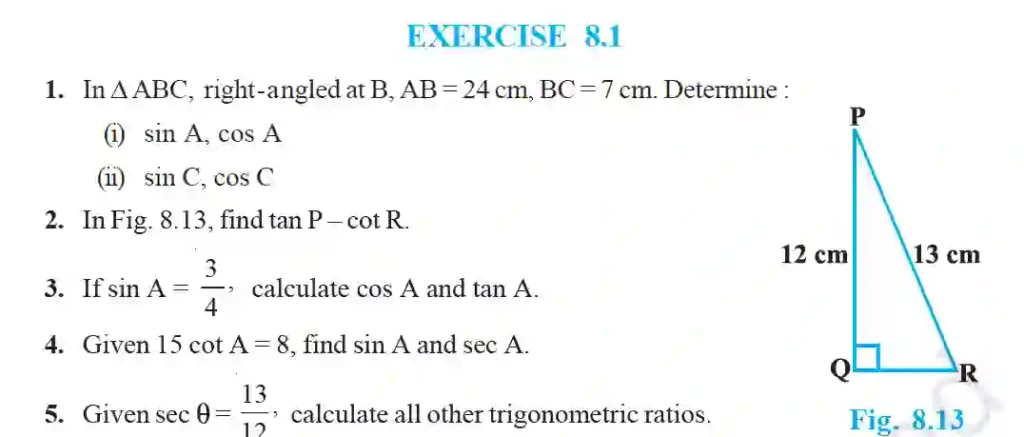 >
>Class 10 trigonometry exercise 8.1
Introduction to Trigonometry
1. In ΔABC, right-angled at B, AB = 24 cm, BC = 7 cm. Determine :
(i) sin A, cos A
(ii) sin C, cos C
Given: A right-angled triangle ABC, with the right angle at B. AB = 24 cm and BC = 7 cm.
Step 1: Find the hypotenuse (AC) using the Pythagorean theorem.
AC2 = AB2 + BC2
AC2 = 242 + 72
AC2 = 576 + 49 = 625
AC = √625 = 25 cm.
(i) For angle A:
Opposite side = BC = 7 cm
Adjacent side = AB = 24 cm
Hypotenuse = AC = 25 cm
sin A = Opposite⁄Hypotenuse = BC⁄AC =
725
cos A = Adjacent⁄Hypotenuse = AB⁄AC =
2425
(ii) For angle C:
Opposite side = AB = 24 cm
Adjacent side = BC = 7 cm
Hypotenuse = AC = 25 cm
sin C = Opposite⁄Hypotenuse = AB⁄AC =
2425
cos C = Adjacent⁄Hypotenuse = BC⁄AC =
725
2. In Fig. 8.13, find tan P − cot R.
Given: A right-angled triangle PQR, right-angled at Q. PQ = 12 cm and PR = 13 cm.
Step 1: Find the side QR using the Pythagorean theorem.
PR2 = PQ2 + QR2
132 = 122 + QR2
169 = 144 + QR2
QR2 = 169 – 144 = 25
QR = √25 = 5 cm.
Step 2: Calculate tan P.
For angle P, Opposite side = QR = 5 cm, Adjacent side = PQ = 12 cm.
tan P = Opposite⁄Adjacent = QR⁄PQ =
512.
Step 3: Calculate cot R.
For angle R, Adjacent side = QR = 5 cm, Opposite side = PQ = 12 cm.
cot R = Adjacent⁄Opposite = QR⁄PQ =
512.
Step 4: Find tan P − cot R.
tan P – cot R = 512 – 512 = 0.
Answer: The value of tan P − cot R is 0.
3. If sin A = 34, calculate cos A and tan A.
Given: sin A = 34.
We know sin A = Opposite⁄Hypotenuse. So, let the opposite side be 3k and the hypotenuse be 4k for some positive constant k.
Step 1: Find the adjacent side using the Pythagorean theorem.
Hypotenuse2 = Opposite2 + Adjacent2
(4k)2 = (3k)2 + Adjacent2
16k2 = 9k2 + Adjacent2
Adjacent2 = 16k2 – 9k2 = 7k2
Adjacent = √(7k2) = k√7.
Step 2: Calculate cos A and tan A.
cos A = Adjacent⁄Hypotenuse = k√7⁄4k =
√74.
tan A = Opposite⁄Adjacent = 3k⁄k√7 =
3√7.
4. Given 15 cot A = 8, find sin A and sec A.
Given: 15 cot A = 8, which means cot A = 815.
We know cot A = Adjacent⁄Opposite. So, let the adjacent side be 8k and the opposite side be 15k.
Step 1: Find the hypotenuse using the Pythagorean theorem.
Hypotenuse2 = Opposite2 + Adjacent2
Hypotenuse2 = (15k)2 + (8k)2
Hypotenuse2 = 225k2 + 64k2 = 289k2
Hypotenuse = √(289k2) = 17k.
Step 2: Calculate sin A and sec A.
sin A = Opposite⁄Hypotenuse = 15k⁄17k =
1517.
sec A = Hypotenuse⁄Adjacent = 17k⁄8k =
178.
5. Given sec θ = 1312, calculate all other trigonometric ratios.
Given: sec θ = 1312.
We know sec θ = Hypotenuse⁄Adjacent. Let Hypotenuse = 13k and Adjacent = 12k.
Step 1: Find the opposite side using the Pythagorean theorem.
Hypotenuse2 = Opposite2 + Adjacent2
(13k)2 = Opposite2 + (12k)2
169k2 = Opposite2 + 144k2
Opposite2 = 169k2 – 144k2 = 25k2
Opposite = √(25k2) = 5k.
Step 2: Calculate all other ratios.
sin θ = Opposite⁄Hypotenuse = 5k⁄13k = 513.
cos θ = Adjacent⁄Hypotenuse = 12k⁄13k = 1213.
tan θ = Opposite⁄Adjacent = 5k⁄12k = 512.
cosec θ = Hypotenuse⁄Opposite = 13k⁄5k = 135.
cot θ = Adjacent⁄Opposite = 12k⁄5k = 125.
6. If ∠A and ∠B are acute angles such that cos A = cos B, then show that ∠A = ∠B.
Step 1: Construct a triangle.
Consider a right-angled triangle ABC, where the right angle is at C (∠C = 90°). This makes ∠A and ∠B acute angles.
Step 2: Write the expressions for cos A and cos B.
In ΔABC:
cos A = Adjacent side to A⁄Hypotenuse = AC⁄AB.
cos B = Adjacent side to B⁄Hypotenuse = BC⁄AB.
Step 3: Use the given condition.
We are given that cos A = cos B.
Therefore, ACAB = BCAB.
Multiplying both sides by AB, we get: AC = BC.
Step 4: Conclude using properties of a triangle.
In a triangle, angles opposite to equal sides are equal.
Since side AC = side BC, the angles opposite to these sides must be equal.
Angle opposite to AC is ∠B.
Angle opposite to BC is ∠A.
Therefore, ∠A = ∠B. (Proved)
7. If cot θ = 78, evaluate:
(i) (1 + sin θ)(1 − sin θ)(1 + cos θ)(1 − cos θ)
(ii) cot2θ
(i) Evaluate (1 + sin θ)(1 − sin θ)(1 + cos θ)(1 − cos θ)
Method 1: Using trigonometric identities (Simpler Method)
First, simplify the expression.
Using the identity (a+b)(a-b) = a2 – b2:
Numerator: (1 + sin θ)(1 – sin θ) = 1 – sin2θ.
Denominator: (1 + cos θ)(1 – cos θ) = 1 – cos2θ.
The expression becomes 1 – sin2θ1 – cos2θ.
Using the identity sin2θ + cos2θ = 1, we have:
1 – sin2θ = cos2θ
1 – cos2θ = sin2θ
So, the expression is cos2θsin2θ = (cos θ⁄sin θ)2 = cot2θ.
Given cot θ = 78, so cot2θ = (78)2 = 4964.
(ii) Evaluate cot2θ
This is simply the square of cot θ.
cot2θ = (cot θ)2 = (78)2 = 4964.
8. If 3 cot A = 4, check whether 1 − tan2A1 + tan2A = cos2A − sin2A or not.
Given: 3 cot A = 4, so cot A = 43.
From this, tan A = 1⁄cot A = 34.
Step 1: Calculate the Left Hand Side (LHS).
LHS = 1 − tan2A1 + tan2A = 1 − (3⁄4)21 + (3⁄4)2 = 1 − 9⁄161 + 9⁄16
LHS = (16-9⁄16)(16+9⁄16) = 7⁄1625⁄16 = 725.
Step 2: Calculate the Right Hand Side (RHS).
First, find sin A and cos A. From cot A = 4⁄3 = Adjacent⁄Opposite.
Let Adjacent = 4k, Opposite = 3k.
Hypotenuse2 = (4k)2 + (3k)2 = 16k2 + 9k2 = 25k2.
Hypotenuse = √(25k2) = 5k.
So, sin A = Opposite⁄Hypotenuse = 3k⁄5k = 35.
And cos A = Adjacent⁄Hypotenuse = 4k⁄5k = 45.
RHS = cos2A − sin2A = (45)2 – (35)2
RHS = 1625 – 925 = 725.
Step 3: Compare LHS and RHS.
Since LHS = 725 and RHS = 725, the statement is true.
9. In triangle ABC, right-angled at B, if tan A = 1√3, find the value of:
(i) sin A cos C + cos A sin C
(ii) cos A cos C − sin A sin C
Given: tan A = 1√3 in a triangle ABC right-angled at B.
We know tan A = Opposite⁄Adjacent = BC⁄AB. Let BC = k and AB = k√3.
Step 1: Find the hypotenuse AC.
AC2 = AB2 + BC2 = (k√3)2 + (k)2 = 3k2 + k2 = 4k2.
AC = √(4k2) = 2k.
Step 2: Find the required trigonometric ratios.
For angle A: sin A = BC⁄AC = k⁄2k = 12 and cos A = AB⁄AC = k√3⁄2k = √32.
For angle C: sin C = AB⁄AC = k√3⁄2k = √32 and cos C = BC⁄AC = k⁄2k = 12.
(i) Calculate sin A cos C + cos A sin C.
= (12) × (12) + (√32) × (√32)
= 14 + 34 = 44 = 1.
(ii) Calculate cos A cos C − sin A sin C.
= (√32) × (12) – (12) × (√32)
= √34 – √34 = 0.
10. In ΔPQR, right-angled at Q, PR + QR = 25 cm and PQ = 5 cm. Determine the values of sin P, cos P and tan P.
Given: ΔPQR is right-angled at Q. PQ = 5 cm and PR + QR = 25 cm.
Step 1: Express one side in terms of the other.
Let QR = x cm. Then PR = (25 – x) cm.
Step 2: Use the Pythagorean theorem to find x.
PR2 = PQ2 + QR2
(25 – x)2 = 52 + x2
625 – 50x + x2 = 25 + x2
625 – 25 = 50x
600 = 50x
x = 600⁄50 = 12.
Step 3: Determine the lengths of the sides.
QR = x = 12 cm.
PR = 25 – x = 25 – 12 = 13 cm.
Step 4: Calculate the required ratios for angle P.
For angle P:
Opposite side = QR = 12 cm
Adjacent side = PQ = 5 cm
Hypotenuse = PR = 13 cm
sin P = Opposite⁄Hypotenuse = 1213.
cos P = Adjacent⁄Hypotenuse = 513.
tan P = Opposite⁄Adjacent = 125.
11. State whether the following are true or false. Justify your answer.
(i) The value of tan A is always less than 1.
False.
Justification: tan A = Opposite⁄Adjacent. The opposite side can be longer than the adjacent side. For example, if Opposite = 4 and Adjacent = 3, then tan A = 4/3, which is greater than 1.
(ii) sec A = 125 for some value of angle A.
True.
Justification: sec A = Hypotenuse⁄Adjacent. Since the hypotenuse is always the longest side in a right-angled triangle, the value of sec A must be greater than or equal to 1. As 12/5 = 2.4 > 1, this is possible.
(iii) cos A is the abbreviation used for the cosecant of angle A.
False.
Justification: cos A is the abbreviation for cosine of angle A. The abbreviation for cosecant of angle A is cosec A.
(iv) cot A is the product of cot and A.
False.
Justification: cot A is a single term representing the cotangent function of the angle A. ‘cot’ by itself has no meaning; it is not a variable to be multiplied by A.
(v) sin θ = 43 for some angle θ.
False.
Justification: sin θ = Opposite⁄Hypotenuse. In a right-angled triangle, the hypotenuse is always the longest side, so the opposite side can never be greater than the hypotenuse. Therefore, sin θ must always be less than or equal to 1. Since 4/3 > 1, this is not possible.


